a few things you should know, if your useing the perimeter design valve covers
read this thread also
viewtopic.php?f=32&t=1000
Ive had the best luck with the extra thick synthetic /cork composite mix gaskets
http://store.summitracing.com/partdetail.asp?part=FPP-1604&autoview=sku
http://store.summitracing.com/partdetail.asp?part=FPP-1630&autoview=sku
BTW using load spreader clip tabs between the valve cover hold down bolts and the valve cover helps prevent leaks, bent or cracked valve covers
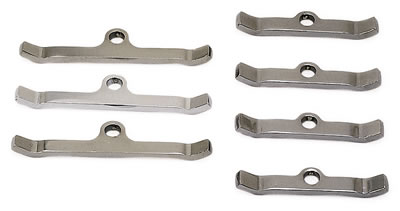
[1] synthetic oil desolves that yellow 3m weatherstrip gasket adhesive than many guys use over a few months time so you cant use it to glue valve cover gaskets
[2]you must use a o2 safe gasket cement like the BLACK RTV silicone cement and you must clean and degrease the cover with acetone or a similar solvent before glueing on the gasket to get the best retention
[3]you need to allow at least a few hours to over night,depends mostly on temp. for that black silicone gasket cement to set up before installing the valve covers, and placeing them gasket side down on a table with a sheet of wax paper under them and a 20lb weight on top of each valve cover while the cement sets up is the best way to insure the gaskets stay correctly aligned on the valve covers perimeter
[4]a light coat of (PAM) cooking spray on the lower gasket surface keeps them from sticking to the cylinder heads after installation
[5] these gasket retaining rings add a great deal to the valve covers ability to firmly hold the gasket WITHOUT bending SHEET METAL VALVE COVERS OR CRACKING CAST ALUMINUM VALVE COVERS AND ARE WELL WORTH THE MINIMAL COST
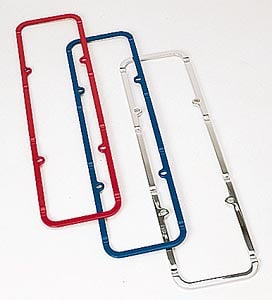
[6]doing it correctly the first time saves time and money
these gaskets work correctly
http://www.summitracing.com/parts/MRG-5861/
http://www.summitracing.com/parts/NAL-14085759/
http://www.summitracing.com/parts/MRG-5863/
http://www.jegs.com/webapp/wcs/stores/servlet/product_10001_10002_25118_-1
are you aware there ARE valve cover spacers to convert standard valve covers into TALL valve covers for clearance, in some cases, and adapters to convert center bolt to perimeter bolt cover designs? in case you want to maintain the stock look to some extent issues
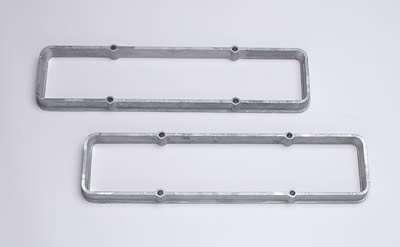
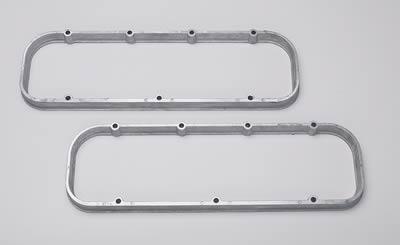
http://www.summitracing.com/parts/STF-63900/
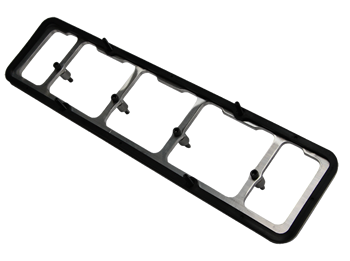
http://www.ansenusa.com/shopexd.asp?id=416
read this thread also
viewtopic.php?f=32&t=1000
Ive had the best luck with the extra thick synthetic /cork composite mix gaskets
http://store.summitracing.com/partdetail.asp?part=FPP-1604&autoview=sku
http://store.summitracing.com/partdetail.asp?part=FPP-1630&autoview=sku
BTW using load spreader clip tabs between the valve cover hold down bolts and the valve cover helps prevent leaks, bent or cracked valve covers

[1] synthetic oil desolves that yellow 3m weatherstrip gasket adhesive than many guys use over a few months time so you cant use it to glue valve cover gaskets
[2]you must use a o2 safe gasket cement like the BLACK RTV silicone cement and you must clean and degrease the cover with acetone or a similar solvent before glueing on the gasket to get the best retention
[3]you need to allow at least a few hours to over night,depends mostly on temp. for that black silicone gasket cement to set up before installing the valve covers, and placeing them gasket side down on a table with a sheet of wax paper under them and a 20lb weight on top of each valve cover while the cement sets up is the best way to insure the gaskets stay correctly aligned on the valve covers perimeter
[4]a light coat of (PAM) cooking spray on the lower gasket surface keeps them from sticking to the cylinder heads after installation
[5] these gasket retaining rings add a great deal to the valve covers ability to firmly hold the gasket WITHOUT bending SHEET METAL VALVE COVERS OR CRACKING CAST ALUMINUM VALVE COVERS AND ARE WELL WORTH THE MINIMAL COST

[6]doing it correctly the first time saves time and money
these gaskets work correctly
http://www.summitracing.com/parts/MRG-5861/
http://www.summitracing.com/parts/NAL-14085759/
http://www.summitracing.com/parts/MRG-5863/
http://www.jegs.com/webapp/wcs/stores/servlet/product_10001_10002_25118_-1
are you aware there ARE valve cover spacers to convert standard valve covers into TALL valve covers for clearance, in some cases, and adapters to convert center bolt to perimeter bolt cover designs? in case you want to maintain the stock look to some extent issues


http://www.summitracing.com/parts/STF-63900/

http://www.ansenusa.com/shopexd.asp?id=416
